Full Text Searchable PDF User Manual
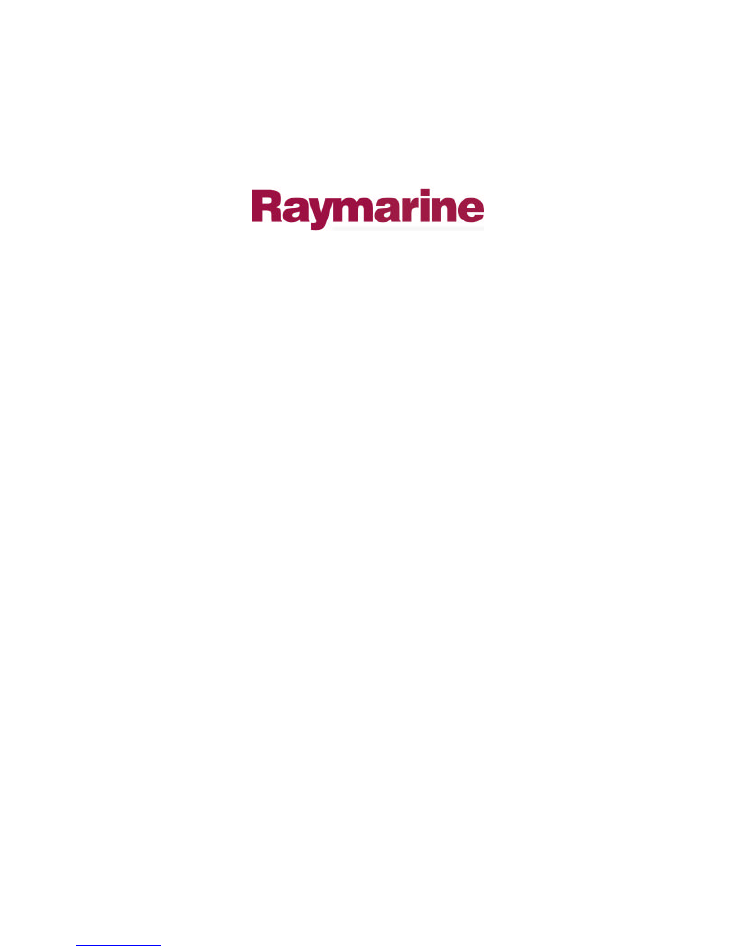
Distributed by
Any reference to Raytheon or
RTN in this manual should be
interpreted as Raymarine.
The names Raytheon and RTN
are owned by the
Raytheon Company.
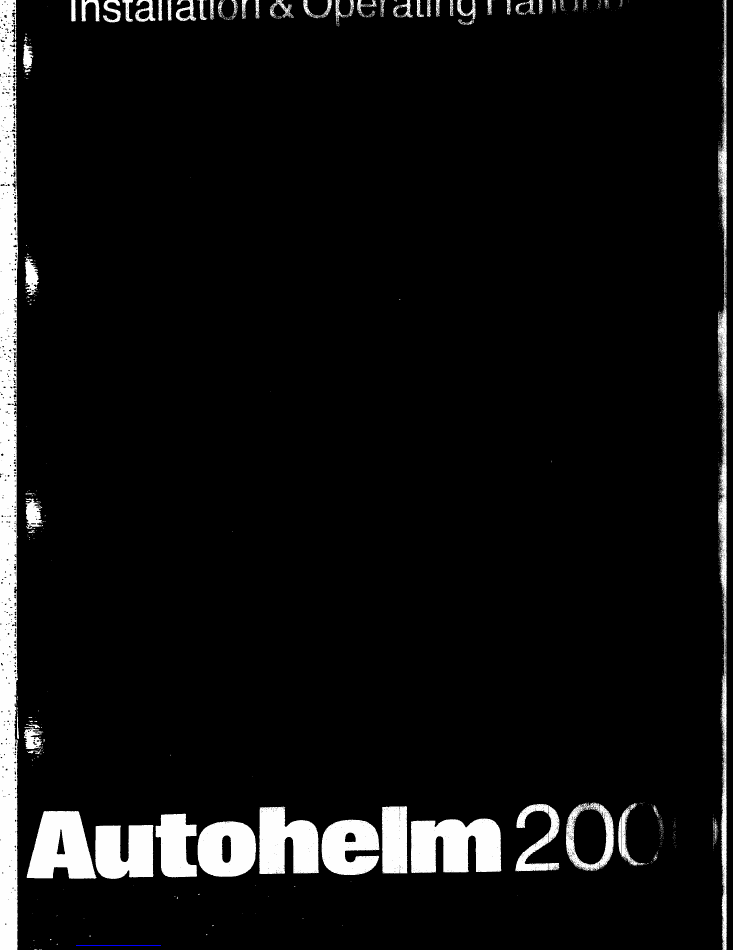
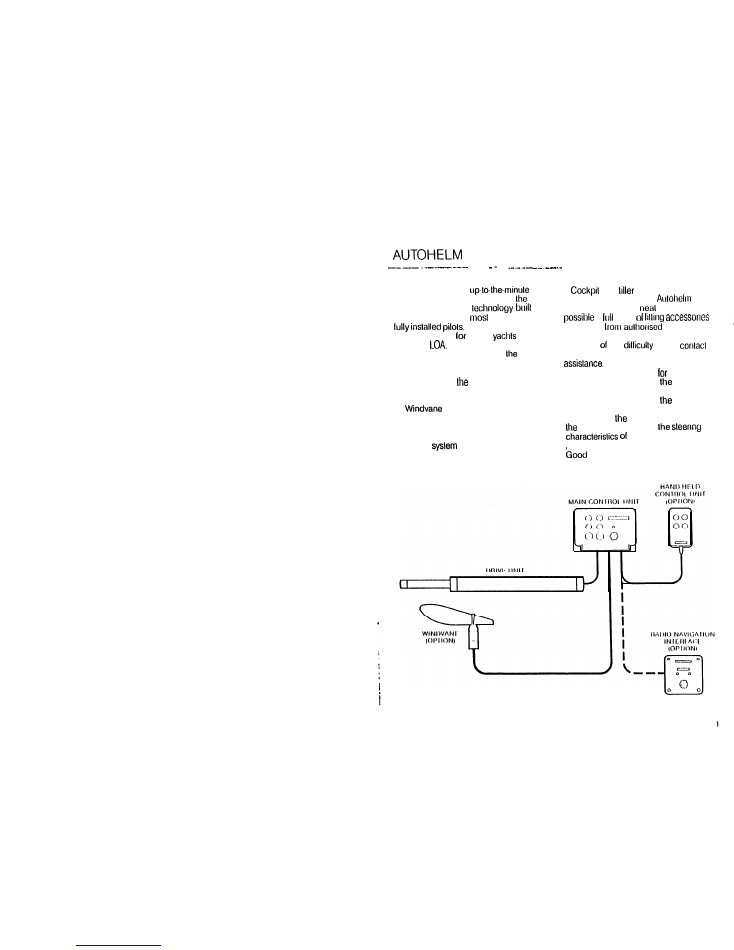
2000
Aulohelm 2000 is an
digital liller autopilot which shares
same microprocessor
into our biggest and
sophisticaled
II will provide precise
powerful sleering
sailing
up lo
13m (43’)
The basic system comprises
main
control unit, liller drive unil and basic
mounting fillings. This can be exlended
by adding any of
following
a c c e s s o r i e s :
l
l
Radio Navigation interlace
l
Hand Held Conlrol Unit
The lull
is shown below.
and
conliguralions vary
widely and lo ensure your
2000 inslallalion is as
and secure as
a
range
is available
Aulohelm
slockisls. Full delails are included.
In case any
please
our Technical Sales Deparlmenl lor
The syslem is designed
owner
inslallalion which aided by
lollowing
guide should prove lo be a simple and
inleresling job. After filling
equipment
it is only necessary lo make a single
adjustment lo
control unit lo match
aulopilols response lo
your vessel.
Sailing!
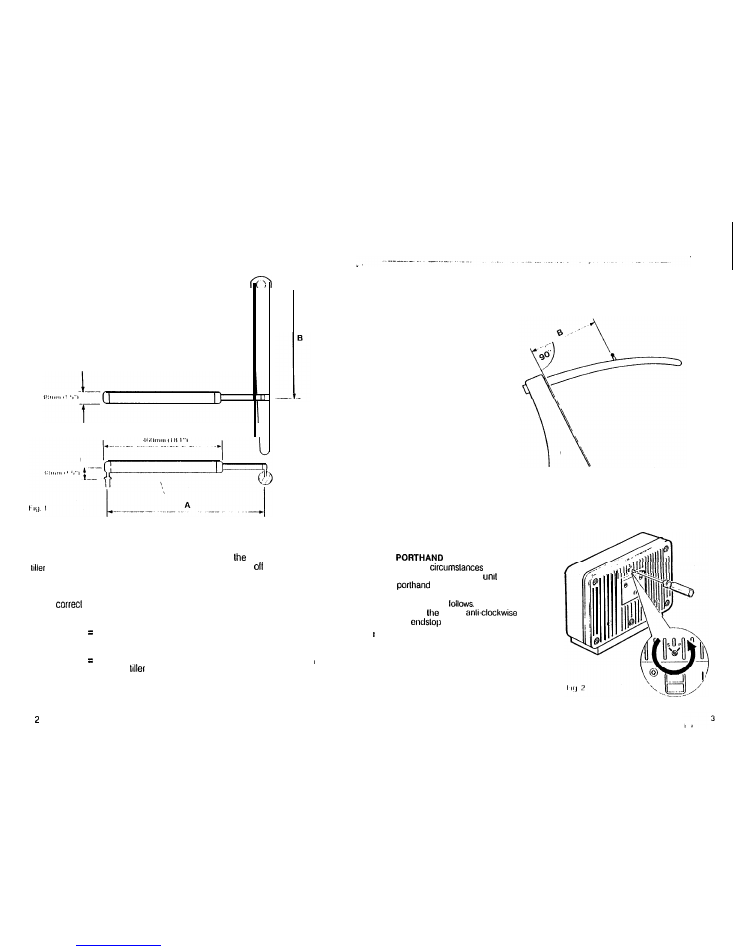
INSTALLATION
DRIVE UNIT
The drive unil is mounled belween the
and a single allachmenl poinl on the
yacht’s structure. After connection to the
yacht’s 12 volt electrical system the unit
becomes operational.
For
installation two basic
dimensions are critical (Fig.l):-
Dimension A 620mm (24.5”)
mounling socket lo tiller pin
Dimenslon B 460mm (16”)
rudder stock cenlre line to
pin
Clamp
tiller on the yacht’s cenlre
line and mark
dimensions A and
B (A
is measured on the STARBOARD side of
the cockpit) using masking tape to locate
the fixing points. Ensure the
measurements are at right angles as
shown.
The drive unit must be mounted
horizontally.
SLOPING RUDDERSTOCK
In certain
it may be more
convenient to mount the
on lhe
side. When this is the case, the
changeover switch will require
adjustment as
Use a screwdriver
to rotate
switch
until
the
is reached (Fig. 2).
Never force the changeover switch,
light pressure only Is required.
MOUNTING
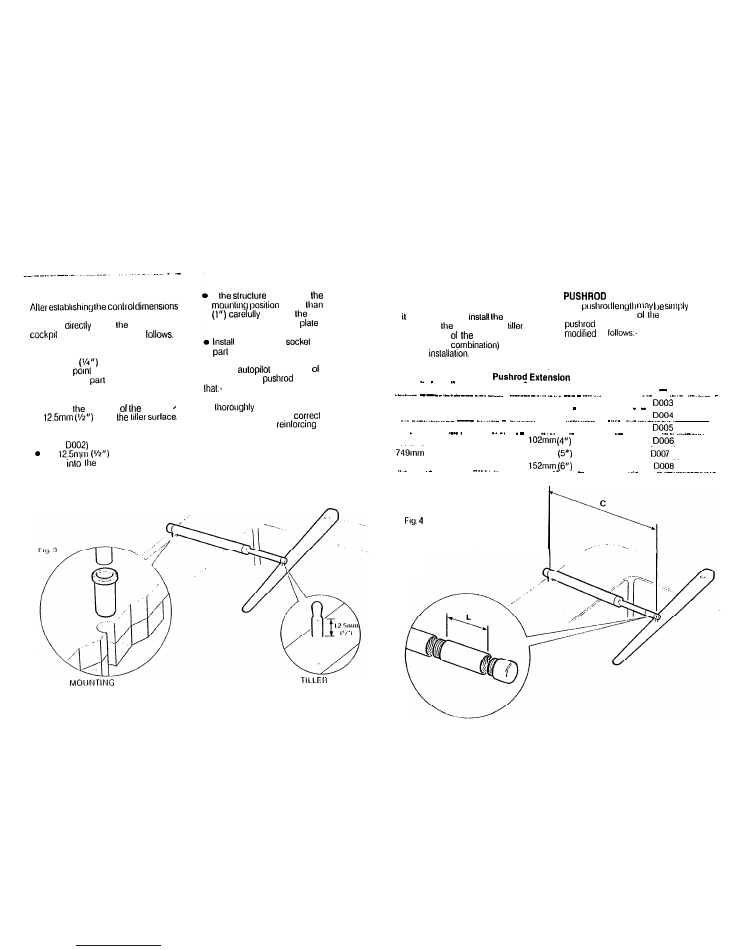
BASIC INSTALLATION
the Aulohelm 2000 can usually be
mounled
onto
Starboard
seal (Fig 3). Proceed as
TILLER PIN (Cal No. 0001)
l
Drill 6mm
hole x 25mm (1”)
deep al
marked.
l
Using a Iwo
epoxy adhesive such
as Araldile, bond the tiller pin into
place.
l
Position
shoulder
pin
above
MOUNTING SOCKET
(Ca! No.
Drill
hole x 25rnrn (1”)
deep
starboard cockpil seal.
II
thickness al
is less
25mm
reinforce
under
surface wilh a plywood
bonded
into position.
the mounling
using Iwo
epoxy adhesive.
Note The
is capable
generating high
loads. Ensure
l
The epoxy is allowed to harden
before applying any loads;
l
Ail holes are drilled to
size and
where necessary
is
provrded.
SOCKET
PIN
INSTALLATION
EXTENSIONS (Fig.4)
ACCESSORIES
The
II is not possible lo
drive unil
directly onto
cockpil seal or
as
described, one
lollowing
accessories (or
will ensure
a perfect
exlended using one
slandard
exlensions. Drrnension C
IS
as
Dimension C
Length L
Cat No.
.
__
622mm (24.5”)
Sld Dimension’
.
646mm (25.5”)
25mm (1”)
673mm (26.5”)
51 mm (2”)
699mm (27.5”)
76mm (3”)
. .
.
724mm (26.5”)
(29.5;;) --
127mm
775rnm (30.5”)
.
--
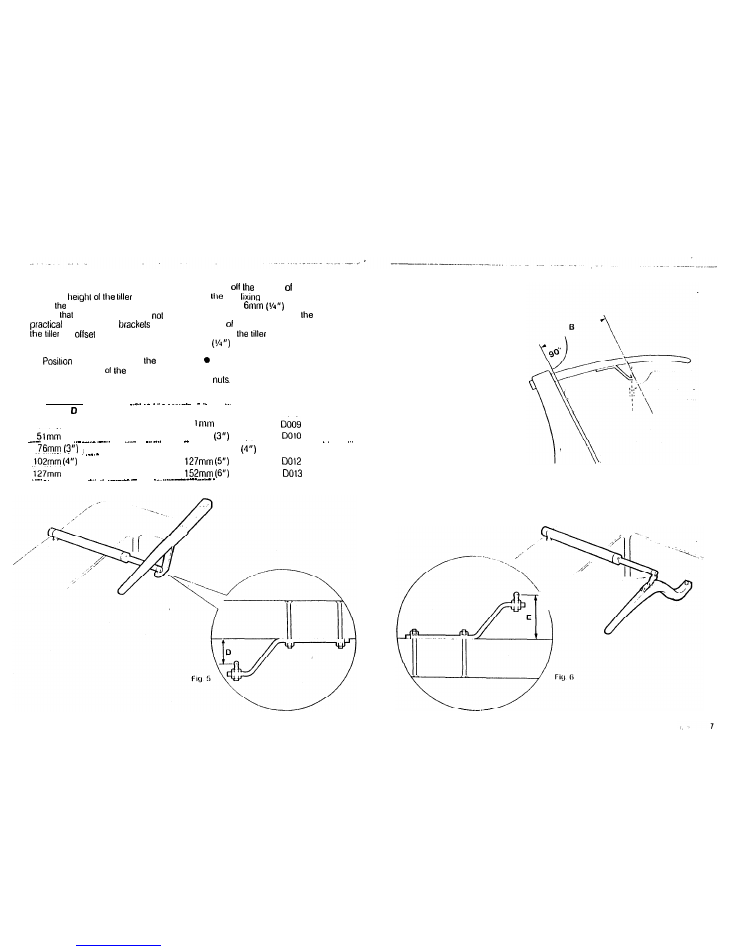
TILLER BRACKETS (Figs.5 and 6)
Where the
above or
below
cockpil seat or mounting plane
is such
slandard mounling is
a range of tiller
allows
pin
lo be varied.
Installation
l
the tiller bracket on
cenlre
line (upper/lower)
tiller and
eslablish lhe control dimensions A
and B.
l
Mark
position the cenlres of
Iwo
boll holes.
l
Drill Iwo
diameler
clearance holes through
cenlre
line
the Irtter.
l
Install
bracket using 2 x 6mm
diameter bolls, nuts and
washers.
Bond lhe lixing bolls in place wilh
epoxy adhesive and fully lighlen the
SLOPING TILLER
Dimension
(below litter)
Dimension E (above litter)
25mm (1”)
5
(2”)
(2”)
76mm
______ __
.
1 0 2 m m
Cat No.
DO11
(5”)
_
_
6
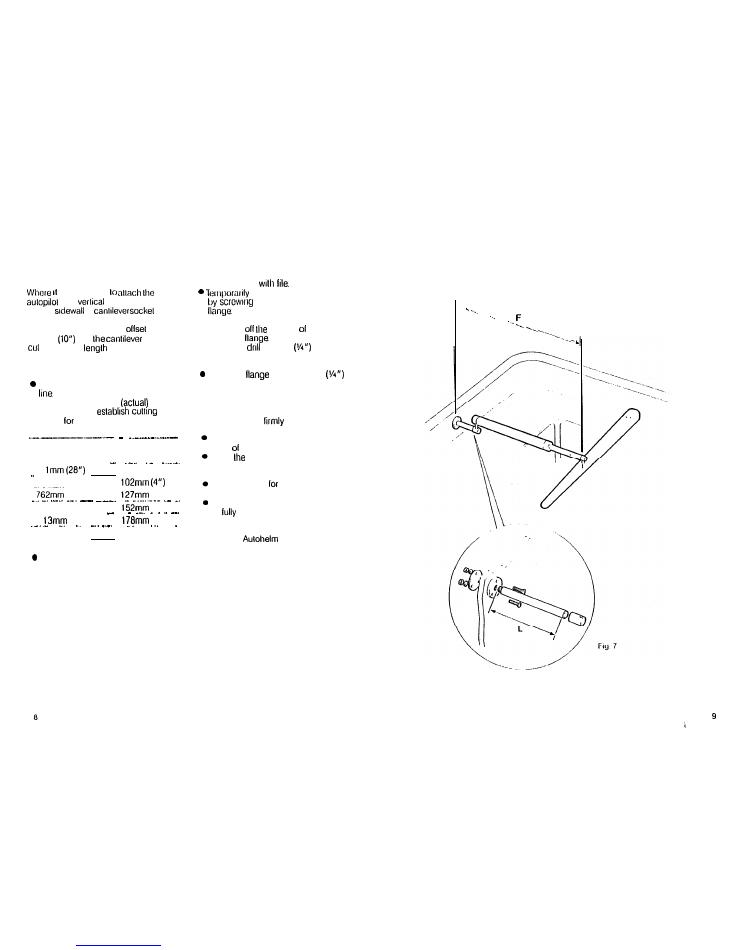
CANTILEVER MOUNTING (Fig.7)
is ncccessary
lo a
lace such as the
cockpit
a
assembly is used.
The maximum exlension
is
254mm
and
can be
IO
the exact
necessary during
mounting.
installation
Clamp the tiller on the yachl’s cenlre
l
Measure dimension
F
l
Refer lo table lo
length
cantilever rod.
Dimension F
Cut Length L
686mm (27”)
51 mm (2”)
71
75mm (3”)
737mm (29”)
(30”)
(5”)
787mm (3 1”)
(6”)
8
(32”)
(7”)
. .
---
838mm (33”)
203mm (8”)
Cut cantilever rod to length
L
using a
hacksaw.
Measure
from threaded end.
l
Remove burrs
assemble the cantilever
the rod into the mounting
l
Ensure lhe drive unit is
horizontal
and mark
location the
mounting
l
Mark and
3 x 6mm
clearance holes (ignore the two inner
holes).
Mount the
using 3 x 6mm
diameter bolts wilh nuts and washers.
Be sure to install the backing plate
correctly. Bed the flange on a thin coal
of silicone sealant.
l
Screw the rod
into place using a
tommy bar.
Roughen the end of the rod and the
inside
the cap to provide a key.
Apply
two part epoxy adhesive
provided to the rod end and cap and
place the cap over the rod end.
Ensure the hole
the drive unit
mounting pin is lacing
up.
Allow the epoxy adhesive 30 minutes
to
harden before applying any
load.
When the
is not in use the
complete rod assembly may be
unscrewed, leaving the cockpit
unobstructed.
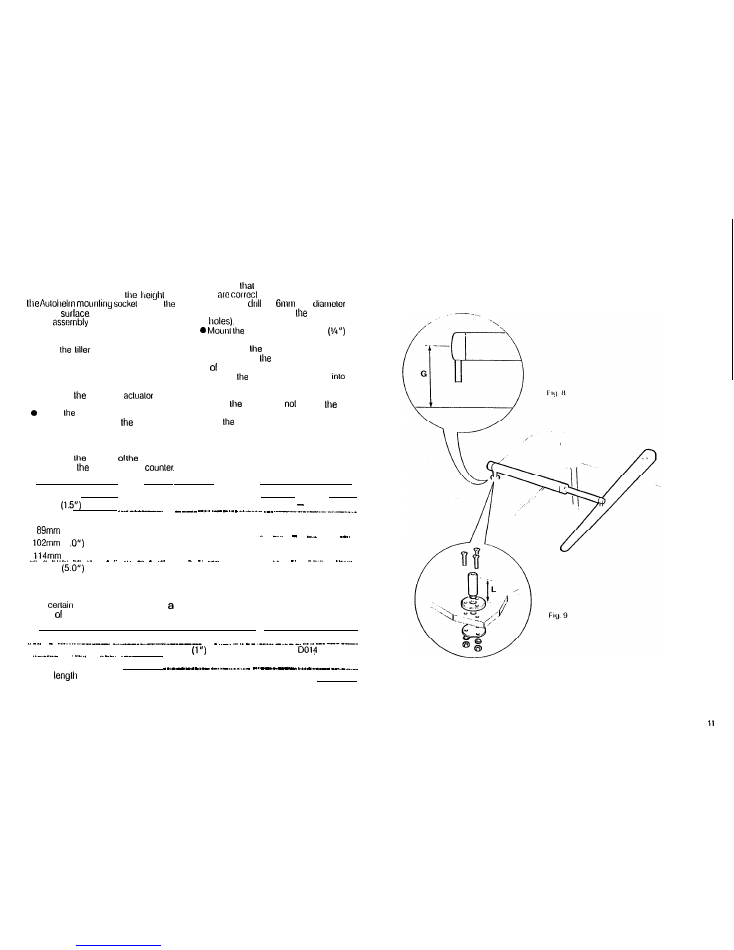
PEDESTAL SOCKET MOUNTING
II may be necessary lo raise
ot
above
mounting
For this a pedeslal
sockel
is used.
Selection
l
Lock
on the yacht’s cenlre
tine.
l
Establish the slandard control
dimensrons
A
and
B.
l
Measure dimension G (Fig.8)
ensuring
Aulohetm
is
horizontal.
Setecl
appropriale pedestal
socket assembly from
table
shown.
Installation
l
Mark oft
position
mounling
llange on
cockpil seal or
l
Ensure
control dimensrons A and
B
l
Mark and
3 x
(V
I
”)
clearance holes (ignore
Iwo inner
ltange using 3 x 6mm
diameter bolls, nuls and washers,
being sure
back ptale is installed
correclty. Bed
ltange on a thin coat
silicone rubber sealanl (Frg.9.)
l
Screw
mounling socket lirmty
place.
When
Aulohelm is
in use
mounling sockel may be unscrewed lo
leave
cockpit unobslrucled.
Dimension G
Pedestal Socket Length L
Cat No.
38mm
Std. Dimension
---
76mm (3.0”)
38mm (1.5”)
DO26
(3.5”)
50mm (2.0”)
DO27
.
(4
64mm (2.5”)
DO28
(4.5”)
76mm (3.0”)
DO29 --
.
__
127mm
89mm (3.5”)
DO30
TILLER PINS
For
non-slandard inslattations
range
litler pins is available.
Description
Sire
Cat No.
. .
Small lhreaded titter pin
25mm
Extra length tiller pin
72mm (2.8”)
D O 2 0
Extra
lhreaded tiller pin
72mm (2.8”)
D O 2 1
10
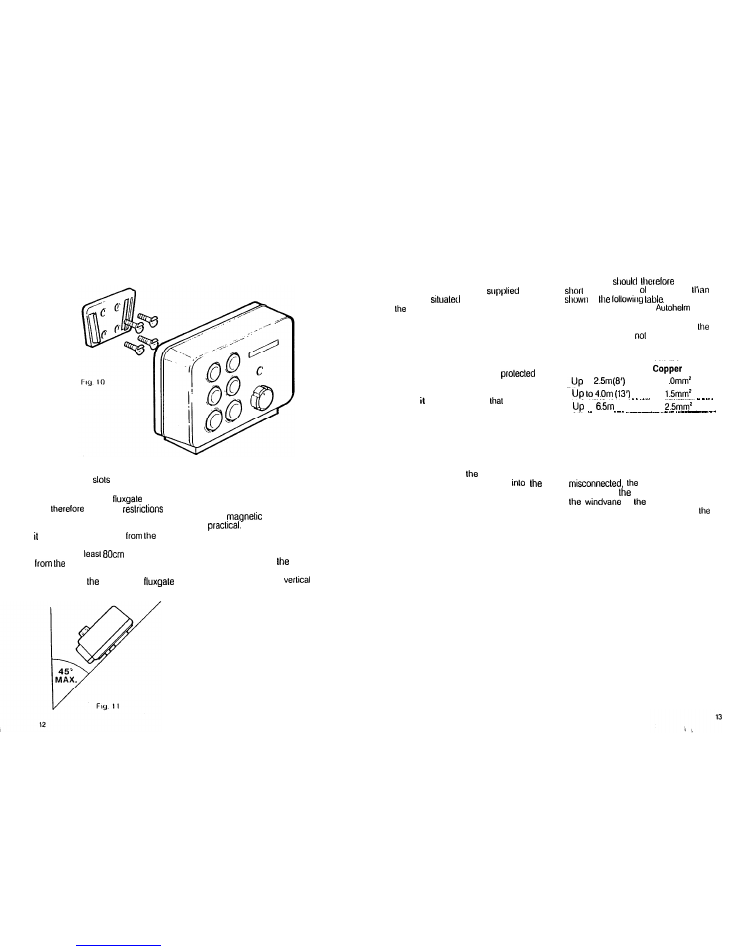
CONTROL UNIT
The conlrol unit
into a permanently
mounled socket sited in the cockpit II
contains a gimballed
compass
and
has some
on
mounling posilion.
The control unit should be siled where
can be operated easily
steering positron. It should also be
posilioned al
(2’6”) away
main steering compass lo avoid
devialion of both compasses.
Deviation of
control unit
compass is less imporlanl since
headings are always adjusted by
reference lo the main sleering compass.
Nevertheless, deviation should be
avoided if possible and thus the conlrol
unit should be siled as far away from
other
or iron devices as
Having selected the besl mounling
site, the mounling sockel may be
secured lo a convenient wooden or glass
libre surface using
self lapping
screws provided. The mounling surface
may slope away from
by a
maximum of 459
Battery Connection
The waterprool ‘Dri-Plug’
should be
as close as possible lo
Aulohelm 2000 lo minimise lead
length. The Dri-Plug sockel musl be
connecled
directly lo
the vessels
electrical dislribulion panel and on no
account paralleled into exisling wiring for
other equipment.
The Aulohelm supply must be
independently switched and
by a 5 amp fuse or current trip.
Since the autopilot is microprocessor
based is very imporlant
vollage
losses in supply cables are minimised.
Supply cables
he as
as possible and
no less size
in
The
brown
wire of the
2000
lead should be connecled
lo positive.
II
connections are accidenlly reversed
Aulohelm 2000 will
operate bul no
damage will result
Lead Length
Area
to
1
__
lo
(22’)
__ __
Accessory Connection
In common wilh all
Aulohelm 2000’s
accessories, the drive unit plugs
conlrol unit lo facilitate slowing and
servicing. To ensure reliable connection
each plug incorporates a locking ring
which should be turned clockwise lo
secure.
Although each accessory has a
unique socket and cannot be
drive unit should be
connected lo
sockel marked
Helm,
to
socket marked Vane
and the hand held remole conlrol lo
sockel marked
Remote.
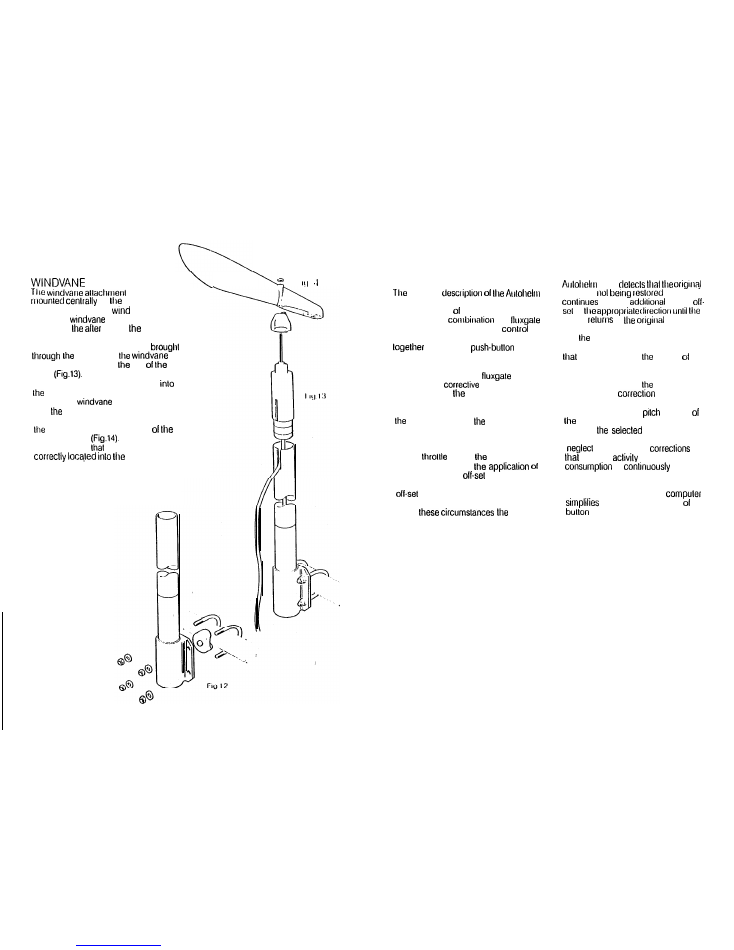
OPERATION
ATTACHMENT
I I
is normally
on
alter rail where
it can be sited in clear
on bolh
lacks. The
mounting masl is
clamped lo
rail by
Iwo ‘U’
bolls provided (Fig.12). The
inlerconnecling cable should be
slol lo allow
head to be plugged into
lop
masl
The inlerconnecling cable
can lhen be run back and plugged
Aulohelm 2000.
Note The
head is supplied
with
vane detached for ease of
packing. The vane is easily assembled lo
head and secured by means
circlip provided
Care should be
laken lo ensure
the small circlip is
groove.
14
BASIC PRINCIPLES
lollowing
2000’s principle of operalion will help you
lo make lull use ils advanced lealures.
The powerful
of a
compass and microprocessor
provides ‘aulolock’ course selection
wilh precise
course
adjuslmenl.
Deviation from course is continuously
monilored by a sensitive
compass and
rudder is
applied lo relurn
vessel lo course.
The applied rudder is proporlional lo
course error al any lime and lhus when
course is restored
rudder will be
neulralised.
When changes in vessel lrim occur
due lo varialions in wind pressure or
engine
selling
course can
only be rnainlained by
permanenl rudder
(standing helm)
lo reslore balance. II permanenl rudder
is nol applied lo restore balance
the vessel will bear on lo a new heading.
Under
2000
course is
and
lo apply
rudder
in
vessel
lo
treading.
Aulomalic lrimming capability ensures
that
originally sel course is held
irrespective of any changes in balance
may occur during
course a
passage.
The Aulohelm 2000’s computer also
continuously monilors
pallern of
applied rudder
and can
distinguish unnecessary repetilive
corrections caused by
and roll
vessel lrom those necessary
IO
rnainlain
heading.
The computer will automatically
,
all unnecessary
so
aulopilol
and power
is
oplimised
al minimum levels.
The high degree of control aulomalion
made possible by the micro
user control lo a series push
operations.
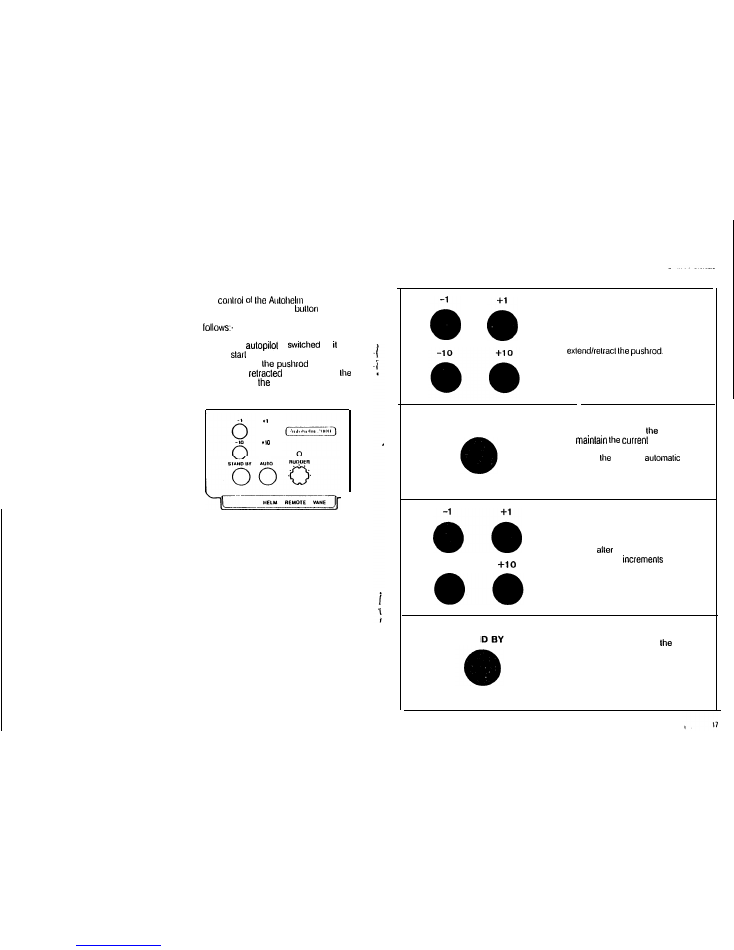
KEYPAD OPERATION
Full
2000 is
provided via a simple six
key pad.
The basic control functions are as
When the
is
on wilt
always
up in Stand by mode. In
Stand by mode
can be
exlended or
lo engage wilh
tiller pin using
four black bullons.
0
0
Push and hold down lo
AUTO
Push once lo engage
aulopilot
lo
heading or
push twice (wilhin 2 seconds) lo
return lo
previous
heading.
Push lo
course lo port (-) or
- 1 0
slarboard (+) in
of 1
and 10 degrees.
STAN
Push once lo disengage
autopilot and relurn to Stand by
mode.
(The previous automatic heading
will be memorised).
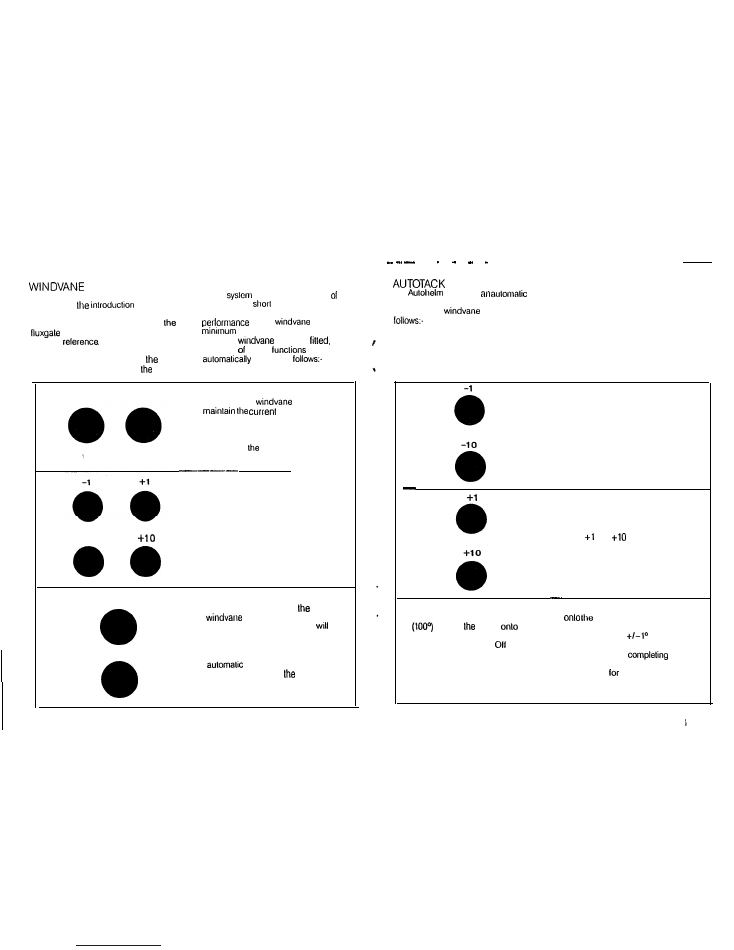
SYSTEM
Pcrlormance under windvano has been
improved by
of Wind
Trim.
Wilh Wind Trim the compuler uses
compass as the primary
heading
However, as changes
occur in the apparent wind angle the
compuler automatically adjusts
compass heading lo maintain
original
apparent wind angle.
This
eliminates the ellecls
turbulence or
term wind varialions
and provides smooth precise
under
with
current consumption.
When a
syslem is
a
new layer
control
is
opened as
Push both red keys togelher once
to engage the
and
apparent wind
angle.
o r
Push both red keys logelher twice
to return lo
previous apparenl
wind angle.
-
-
-
Push once to alter the vessel’s
heading relative lo the apparent
wind in increments of 1 or 10
degrees.
Note + keys always turn the vessel
to starboard.
- 1 0
STAND BY
AUTO
Push once lo disengage
for manual sleering. (The
previous apparent wind angle
be memorised).
o r
Push once to change over to ,
compass heading
control and maintain
current
heading.
FUNCTION
The
2000 has
lacking lunction which operales in both
compass and
mode as
Push -1 and -10 keys logelher
once to iniliale a tack to port.
The Aulo Tack function operales by
selecting a preset course change
to bring
vessel
the
opposite tack.
During the tack, the
Course
Alarm may sound. This indicates
the autopilot is adjusting trim to
acquire the new course.
On completing the tack and
having sheeted and retrimmed the
Push
and
keys togelher
once lo initiale a lack to starboard.
sails, the vessel rnay be brought
desired apparenl wind
angle by line adjuslmenls lo lhe
course using the
keys. No
adjustments should be made
within 1 minule of
the
tack to allow the Autopilot to
compensate
the helm trim on
the new tack.
19
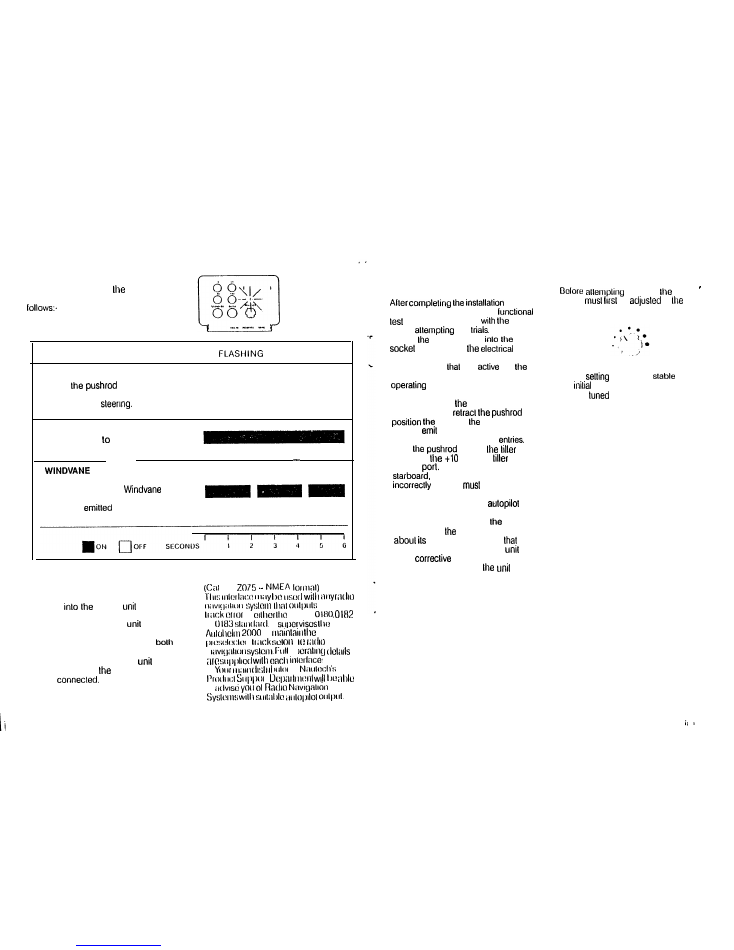
OPERATING MODE INDICATION
The operating mode of
Aulohelm
2000 is indicated by a flashing LED as
OPERATING MODE
LED
CODE
STANDBY
Enables
lo be
positioned over the tiller pin and
1 I I
provides power
AUTO
Autopilot steers
maintain
compass heading.
-
-
Aulopilol sleers lo maintain
apparent wind angle.
mode is also confirmed by a single
beep tone
every 30
seconds.
Hand Held Control Unit
An optional hand held conlrol unit can be
plugged
control
to
provide
(Cat No. 2076)
full course change capability from
anywhere on board. The
duplicates
the main control units four course
change keys and may be used in
Stand by and Auto modes. The
operalion of the main conlrol
is
unchanged when
hand held conlrof
unit is
Radio Navigation Interface
cross
lo
NMEA
No
or
II
lo
I
II
I
of
or
I
IO
FUNCTIONAL TEST
PROCEDURE
you
should carry out the following
lo familiarise yourself
syslem
before
sea
Plug
Aulohelm 2000
power
and switch on
supply. The unit will emit a short beep
Lone lo indicale
it is
and
LED will flash to indicate Stand by
mode.
Ensure the mounting pin is engaged in
the socket. Using
four course control
keys to extend or
end over
tiller pin. The
unit will
a short beep lone on each
press of a key lo confirm valid
Place
end on
pin,
and press
key. The
should
move lo
II the litter moves to
the changeover switch is
set and
be adjusted as
described on page 3.
Press Auto lo place the
under compass control. The LED will be
tit constantly to indicale that
unit is in
Auto mode. If
yacht is swinging
mooring, you will see
small
variations in heading cause the
to
apply
action lo the rudder.
Press Stand by lo relurn
lo
Stand by mode.
Rudder Control Adjustment
sea lrials
rudder
conlrol
be
lo
selling shown below.
This
will provide
control
for
sea trials and may, if necessary,
be fine
later (see page 25).
20
21
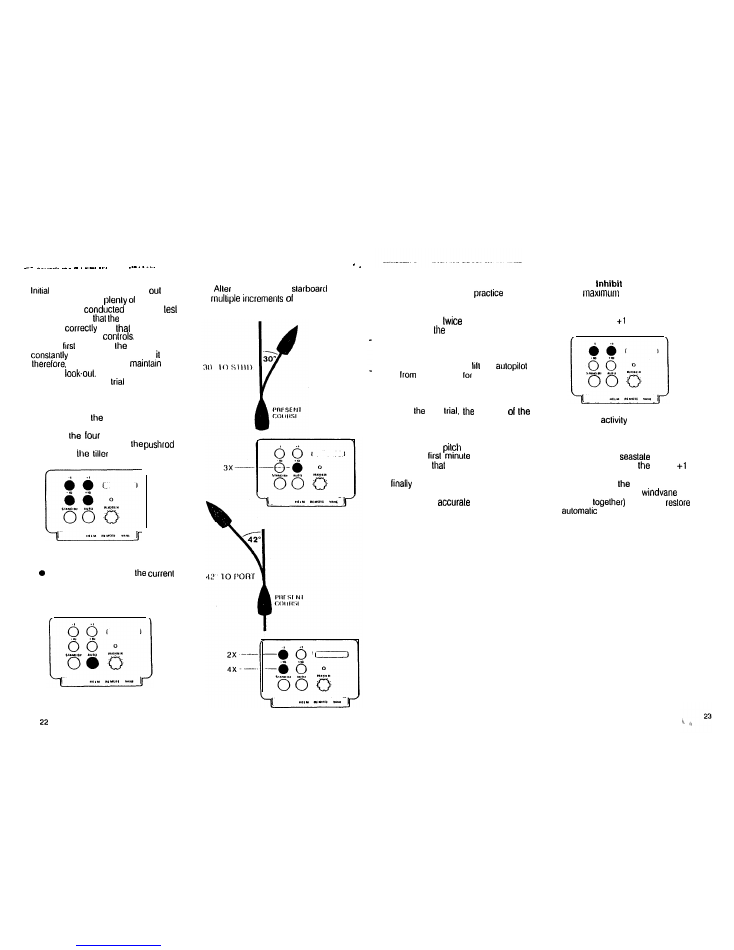
SEA TRIALS
--
sea trails should be carried
in
calm conditions with
sea room.
The previously
functional
will have verified
aulopilol is
operaling
and
you are
familiar with all of its
During
sea trials.
vessel will be
changing heading, and is,
very imporlanl lo
a
constant
The following initial
procedure is
recommended:-
@ Steer on to
desired heading and
hold the course steady.
l
Using
course control keys,
position and lhen place
end over
pin.
Press Auto lo lock on lo
heading. In calm sea conditions a
perfectly constant heading will be
maintained.
l
course lo porl or
in
1 and 10
degrees.
Power Steering
l
Press
Stand by
and
power
steering using the four course conlrol
keys.
l
Press
Auto
(wilhin 2 seconds) lo
return to
original automatic
heading.
Hand Steering
l
Press
Stand by
and
the
the tiller pin
return to hand
sleering.
Automatic Sea State Control
During
sea
operation
automatic sea stale conlrol can be
observed. When the aulopilol is initially
engaged in
Auto
mode the aulopilot will
respond lo all
and roll movemenls.
During the
of operation, it will
be noticed
repetitive movements of
the vessel are gradually neglected until
the aulopilot will respond only lo
true varialions in course.
To ensure
course adjustment
the sea stale control is automatically reset
whenever a 10 degree course change is
executed.
Sea State
Where
course keeping
accuracy is required the automatic sea
stale control may be inhibited by
pressing -1 and
keys together once
Autopilot
and lherelore power
consumption will be increased but
, course keeping accuracy will be
maximised.
The automatic
control is
reslored by pressing
-1 and
keys
together.
Note
Engaging
autopilot (pushing
Auto)
or engaging the
(both
red keys
will always
the
sea state conlrol.
i
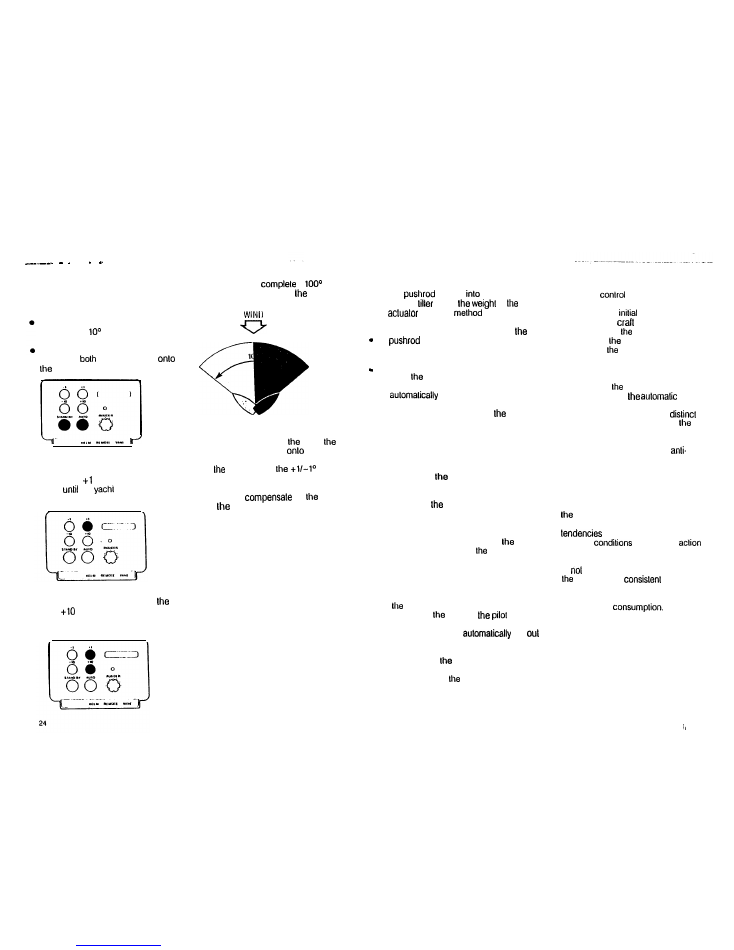
Auto-Tack Function
The following addilional trial is
recommended:
Steer onto a constant heading
approximately
free of close
hauled
Press Auto to lock onto the current
heading or
red keys lo lock
apparenl wind if a vane is filled.
l
Decrease the apparenl wind angle
(using the
key if on the slarboard
lack)
the
is sailing close
hauled al oplimum penetration.
l
Prepare to lack and then press
+ 1
and
keys together (if on the
starboard lack) to initiate a lack
I
O
slarboard.
l
The yacht will
a
course
change
IO
bring it onto
opposite
lack.
1
.
On compleling lhe lack and having
sheeted and retrimmed
sails,
vessel may be brought
the desired
apparent wind angle by fine adjuslmenls
lo
course using
keys. No
adjuslmenls should be made within 1
minute of compleling the lack lo allow the
Autopilot lo
for
helm trim
on
new lack.
Disengagement
The
is held
engagement
wilh the
pin by
of
unit. This
of
engagement is secure and has been
adopted for safely reasons lo allow
lo be easily disengaged when
manual override becomes necessary.
OFF-COURSE ALARM
When
autopilot is set lo either Auto or
Vane mode a built in off-course alarm is
sel up. The off-course
alarm will sound when the vessel
deviales for any reason from
original
course by more than 15 degrees for over
10 seconds. II is denoled by a continuous
series of bleep lones.
The alarm will be silenced if the vessel
returns to within 15 degrees of the
original course.
In Auto, if
vessel does not return
within these limils the alarm can only be
silenced by selecting Standby.
In Vane,
alarm will sound when the
wind direction changes by more lhan 15
degrees and may be accepted by
pressing bolh red keys together. This will
silence the alarm and advance
off
course alarm datum to
current
compass heading.
CURRENT LIMITING AND
.
CUTOUT
If the autopilot is driven into its end stops,
drive will be pulsed lo prevent
.
overloading
motor. If
is left in
this condition for 30 seconds the
microprocessor will
cut
power to the motor and sound the alarm
continuously.
To restore
autopilot for normal
operation the standby key must be
pressed lo put
unit in standby
operating mode.
Rudder Control Adjustment
The rudder
setting
recommended on page 21 will provide
slable control for
sea trials.
However, sailing
can vary widely in
their response lo
helm and further
adjustment of
rudder control setting
may improve
Autohelms steering
characteristics.
An excessively high rudder control
selling results in oversteer which can be
recognised by
vessel swinging slowly
lrom side lo side of
heading accompanied by excessive
rudder movemenl. In addition,
overshool will be observed when
course is changed. This condition can be
corrected by reducing the rudder control
selling (rolaling rudder control
clockwise).
Similarly, an insufficient rudder control
selling results in understeer which gives
sluggish sleering performance and is
particularly apparent when changing
course. This is corrected by increasing
rudder control selling (rotating
rudder control clockwise). These
are most easily recognised in
calm sea
where wave
does not mask basic sleering
performance. The rudder control setting
is
over critical and should be sel lo
lowest selling
with
accurate course keeping. This will
minimise actuator movements and hence
reduce power
25
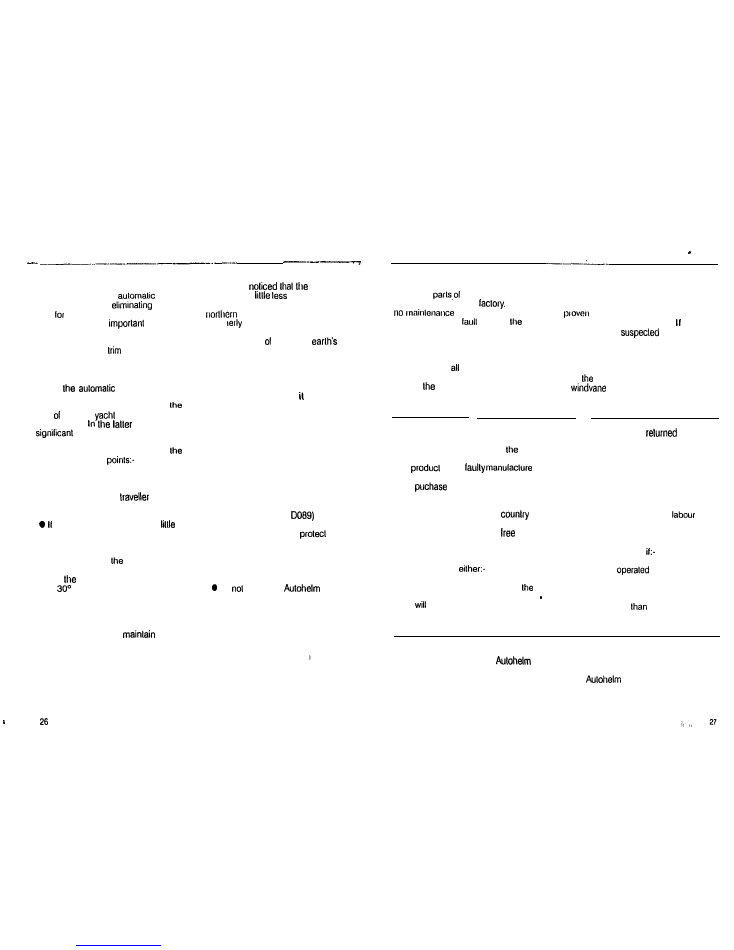
OPERATING HINTS
The Aulohelm 2000’s computer
continuously optimises
steering performance
the
need
operalor supervision.
II is, however, very
lo
undersland the effect of sudden trim
changes on steering performance. When
a sudden change in
occurs the
automatic trim compensation system
requires approximately 60 seconds to
apply the necessary rudder off-set to
restore
heading. In gusling
condilions, therefore, the course may
lend lo wander slightly. particularly in
case a sailing
with badly
balanced sails.
case, a
improvement in course
keeping can always be obtained by
improving sail balance. Bear in mind
following imporlanl
l
Do not allow the yacht lo heel
excessively.
l
Ease lhe mainsheel
lo
leeward lo reduce heeling and
weather helm.
necessary reef the mainsail a
early.
II is also advisable whenever possible
lo avoid sailing with
wind dead astern
in very slrong winds and large seas.
Ideally,
wind should be brought al
least
away from a dead run and in
severe conditions il may be advisable to
remove the mainsail altogether and sail
under headsait only. Providing lhese
simple precautions are taken the
autopilot will be able to
competent control in gale force
condilions.
It may be
autopitol
tends lo be a
slable on northerly
headings in the higher lalitudes of the
hemisphere (and corivcrscly
soutt
headings in the southern
hemisphere). This is caused by the
increasing angle dip of the
magnetic field at higher latitudes which
has the effect of amplifying rudder
response on northerly headings. The
tendency towards norlherty heading
instability is usually more obvious al
higher speeds and when occurs can
be corrected by reducing the rudder
control selling.
Passage making under automatic pilot
is a very pleasant experience which can
lead lo the temptation of relaxing
permanent watch. This must always be
avoided no malter how clear the sea may
appear to be.
Remember, a large ship can travel Iwo
miles in five minutes -just the lime it takes
lo make a cup of coffee!
TOTE BAG
(Cat No.
A special zip top padded bag made from
lough PVC is available lo
and
stow your Aulohetm and is available from
Autohetm slockisls.
W a r n i n g
l
Do not slow your Aulohelm in a locker
liable to flooding by the bilge water.
Do
leave your
in a damp
locker over the winter lay up period.
MAINTENANCE
All moving
the system have been
lubricated for life at the
Therelore
whatsoever will be
required. Should a
develop
autopilot’s plugabilily ensures that only
the defective unit need be returned.
Before lhis is done please double
check that the power supply cable is
sound and that
connections are light
and free from corrosion.
Since
control unit is lhe most
complex, there is a very high probability
that if a fault has occurred it is in this unit
which should therefore be returned for
repair, which wilt be carried out speedily
and al moderate cost. The drive unit has
lo be extremely reliable and is
very unlikely to develop a fault. however
the drive unit is
of being faulty
it may be checked by connecting 12V
across the sockets al the end of the drive
unit cable and ensuring the motor runs
normally.
In
case of a sailing yacht fitted with
a
system if a fault occurs only
in vane mode then it is likely lhal a fault
has developed in the vane head.
LIMITED WARRANTY
Naulech or ils appointed Distributors or
Service Cenlres will, subject lo
condilions below, rectify any failures in
this
due to
which become apparent within two years
ot its
date.
Equipment used in lhe country of
purchase should be sent directly to the
aulhorised Distributor for that
or
its appointed Service Cenlres. The
product will then be serviced
of
charge and returned promptly direct to
the sender.
Equipment used outside the country of
purchase can be
a. Returned to the Distributor or Dealer
in whose country or from whom
equipment was originally purchased
it
then be serviced free of charge
and promptly returned direct to the
sender, or
b. The product can be
freight
pre-paid to the authorised Dislributor
or its appoinled Service Centres in the
country in which the product is being
used. II will then be serviced and
returned direct lo the sender on the
basis that the Distributor or Service
Centre will supply any parts used free
of charge but the sender will be
invoiced for the necessary
and
return shipment at the local rate.
CONDITIONS
The warranty is invalid
a. The product has been misused,
installed or
not in
accordance with the standards
defined in this manual.
b. Repairs have been attempted by
persons other
Nautech approved
Service personnel.
AFTER SALES SERVICE
Centres. You will find a list enclosed.
Should for any reason your
Each service cenlre is trained and
2000 require attention ensure that you
return it lo one of the Authorised Service
equipped lo provide expert allenlion to
your
2000.
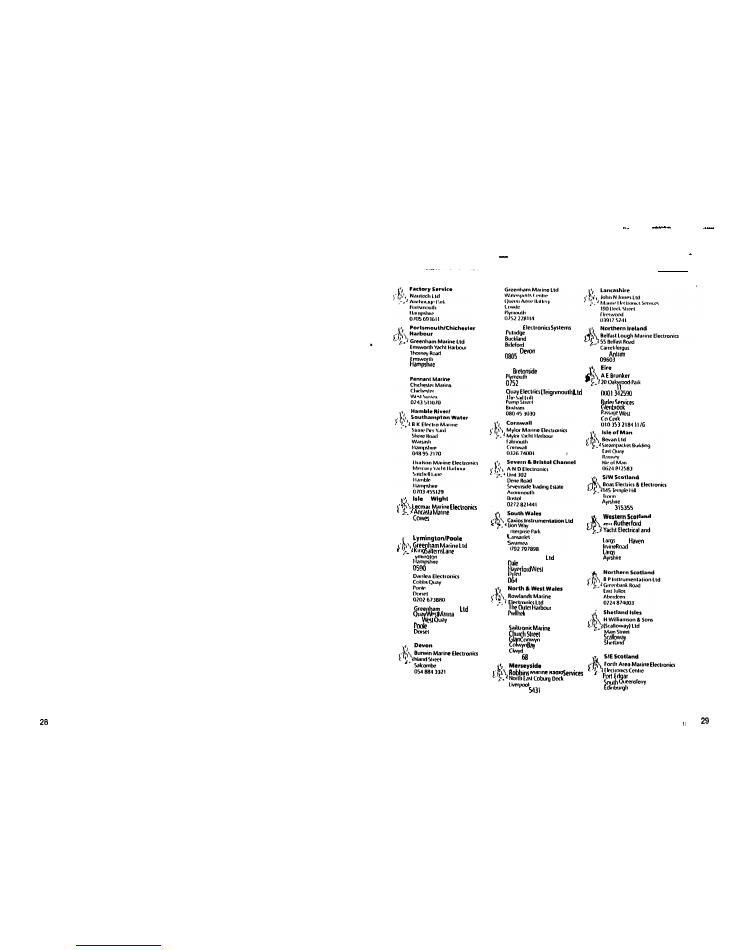
SERVICE CENTRES
UK, Eire and Channel Islands
0 2 4 3 3 7 8 3 1 4
of
low
0983 293996
I
75771
Marine
2 3
Road
0202676363
Marine
Brewer
North
22870
c o
65565
Ocean Marine Servicer
43
2 3 9 2 2
Dublin
E
a
Dale Sailing Co
65 349
0758613193
0492
536
059588645
Marine Radio
.
051709
0313314343
0292
Jell
Electronic Services
Yacht
0475686091
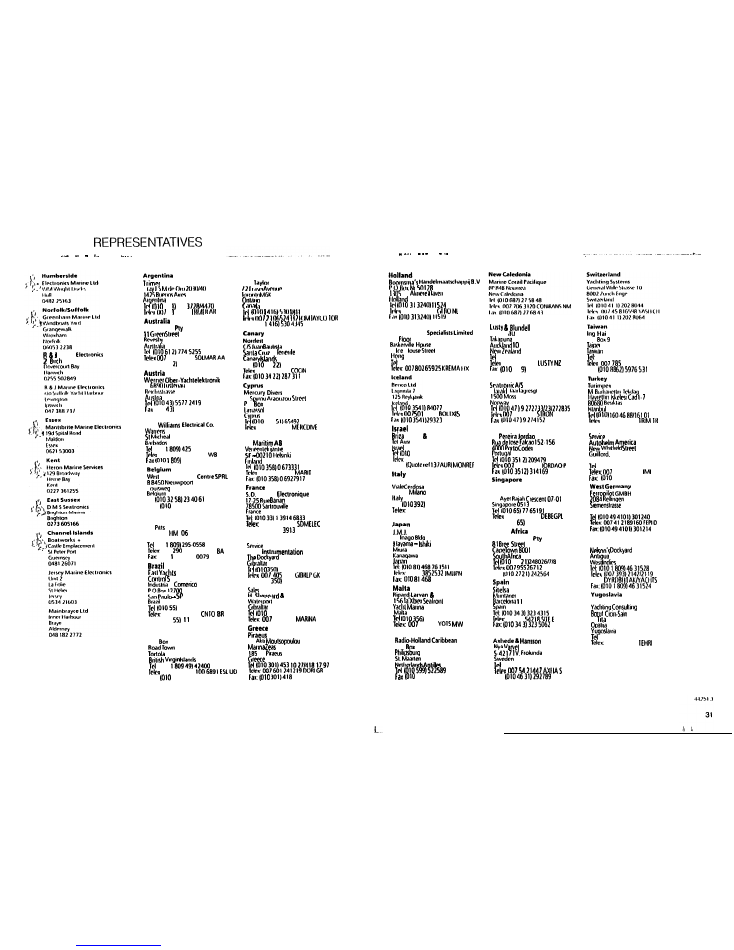
OVERSEAS
New Zealand
Limited
89 Wait Road
(010 64 9) 444 3675
007 74 60324
64 444 3798
Norway
I
I
5
56 76547
N
Portugal
A .
404 22308
Communications Systems
Engineering Pte Ltd
67
007 87 23036
Fax: (010
77 66795
South
Central Boating
Limited
27
SA
far
44
007 52
S.A.
I
5 4 774
3 21653
Canada
lom
Co Ltd.
31 I
AC
no744 70171
Hong Kong
Far East Yacht
M2
22 I
Kong
~010852~525701515 229394
Solo Marine
Ltd
NSW 2212
71 127045
Far (01061 7745291
A
38
,010
5577 24195
far (010
Islands
57
de
Tel
34
284 871
007 52 92230
E
Co. Limited
53
0
469
357
007 605 4976
CY
Company Limited
PO
54
10108862~5312088
13951 VIRAGO
Fax
Marine
Avenue
32
00760726613
USA
Cl 06437
U S A
(010 I 2031453 8753
230643 804
1203) 453 6109
2 334
Yacht Marine Supply
P 0. Box 39232
Barbados
C.O.
Ltd
(010
2250
007 392 2366 COW
474 0374
Diep Yachting
I
2
Tel
Fax.
32 5815823 9246
Bermuda
Finland
Oy
I
007 57 124788
SF
9721320 259913284432
265871
G
35
West Germany
Deck Marine
155
20151
Marine
007 42 698347
Fax (010 33) I
3022
Gibraltar
Bond
73701
237.3
Far: (010
73726
West Indies
The Signal Locker
AK
Mate Nostrum
M
85
~0103851~713506
007 62 24215
YU
Tel
308 7229
007 43 353147 DECK I
Fax: (010 392) 301 3398
Marine Communications
72
flay Road
Pembroke
Bermuda
010
007
3795 MARCO
(010 8091292
A
Limited
2F
370
007 72
I
76 1044
E
11 5211944
007 38 1124612
Fax- (010
5482070
British Virgin Islands
Cay Electronics
P 0
345
(010
007 255510
Fax
1809 49) 44707
Co.
350) 77183
405 2324
GK
Ripard
35591
406 994
Electronic
46
36
1091
Netherlands Antilles
N V
PO.
146
599) 522589
Sweden
(01046311291111
Fax:
3 0